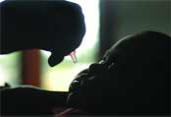 |
|
|
‘A five times more potent vaccine was introduced
without informed consent, nor was the public told
the vaccine was experimental,’
says Dr Jacob Puliyel |
Surrounded by mango groves, village Rahimabad is situated 10
kilometers off the Lucknow-Sitapur highway in the Khairabad
block of Sitapur district. Rahimabad is in news for a
dubious reason. A two-year-old girl of this village, Saniya,
suffers from Type I polio despite being administered more
than seven doses of the new polio monovalent vaccine
(MOPVI), which is made specially for the Type I poliovirus.
The vaccine was introduced in mid-2005 and tom-tommed as the
final step in the eradication of polio from India. Before
its introduction, a trivalent vaccine was in use that
simultaneously targeted the three poliovirus strands found
in India, Type I, II and III, by introducing into the body
live viruses of all the three strands to develop immunity.
Saniya’s is not the only case. There are 15 cases of Type I
polio spread across Uttar Pradesh (There are also 41 cases
of Type II polio which takes the total count to 56). While
there has been no reported Type I case in the endemic
Moradabad, the new cases have been reported from eastern and
central Uttar Pradesh; so instead of just a region, cases of
wild polio are being reported from all over Uttar Pradesh
now.
Saniya’s mother, Noorjahen, is furious. “She is having polio
drops ever since she was four days old. She has had over a
dozen doses of the polio drops. We came to know about her
polio when she got a high fever. She could barely manage to
stand, could not walk at all, after the fever. We took her
to the local hospital where they did a stool test. We were
later told that she has polio,” she recounts. “There must be
some thing wrong with the polio drops if even after so many
doses my child has contracted polio. The government should
test medicines before they are used. Pata nahin bachchoo ko
kya pila rahin hain!” (Don’t know what they are making my
child drink), she adds.
Mistrust is not only rife among the patients’ families, it
has also gripped the doctors and field operatives overseeing
the vaccination project. Add to this the latest controversy
about the MOPVI vaccine, introduced in India by the World
Health Organisation (who), and the organisation’s National
Polio Surveillance Project (NPSP), and you get a sense of
the callousness plaguing the polio campaign.
When the MOPVI was launched in India in mid-2005, there was
no mention that it was a new vaccine, and therefore no need
was felt to examine whether it had been tested. The
impression created at the time was that this vaccine had
earlier been used in the 60s and 70s in some other
countries. The project manager of the NPSP, Dr Hamid Jafari,
confirmed this while talking to Tehelka.
In contrast to this position, the April 21, 2007, issue of
the renowned medical journal, Lancet, carried a study titled
“Protective efficacy of a monovalent oral Type 1 poliovirus
vaccine: a case-control study by Grassly NC, Wenger J,
Durrani S, Bahl S, Deshpande JM, Sutter RW, Heymann DL and
Aylward RB”. On pages 1356-1362 it says: “A high-potency
monovalent oral type 1 poliovirus vaccine (mopv-i) was
developed in 2005 to tackle persistent poliovirus
transmission in the last remaining infected countries. Our
aim was to assess the efficacy of this vaccine in India.”
Cases of Acute Flaccid Paralysis have risen in UP since
the new vaccine was introduced |
This clearly means that the MOPVI is a new, untested vaccine
and its use was part of an experiment. This news has
outraged the Indian medical community. If this vaccine was
new, did the who and NPSP test its safety? Head of the
pediatrics department of Delhi-based St Stephen’s Hospital,
Jacob Puliyel, took up the matter with Lancet. In his
strong-worded letter to Lancet’s editor, he wrote: “We are
shocked and dismayed that Lancet should have published the
paper on the protective efficacy of monovalent oral Type I
poliovirus...having overlooked the serious ethical issues
involved.” He went on to write, “What was introduced,
according to this article, was a new vaccine that was five
times more potent than previous vaccines, presumably also
with the increased likelihood of adverse effects. No
informed consent was taken, nor was the public told that the
vaccine was experimental. Efforts were made to give the
impression that the monovalent vaccine was not new.”
Lancet asked the authors of the article to respond to the
questions raised by Puliyel. In their reply, the authors
bypassed the question whether the vaccine was new or not,
and put the onus of use of this vaccine squarely on the
government of India. “The vaccines assessed were licenced
for administration in India by the national regulatory
authority, the Drugs Controller General of India. The MOPVI
formulation assessed in our study has been used since
mid-2005 by the Government of India, and now in over 20
countries around the world.”
When Tehelka asked the same question to Jafari, he said it
wasn’t a new vaccine. Then why does this paper in Lancet say
so? “It has been interpreted wrongly,” Jafari said.
Continue to untested Vaccine